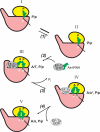The ribosome as a conveying thermal ratchet machine
- PMID: 19416977
- PMCID: PMC2755833
- DOI: 10.1074/jbc.X109.001552
The ribosome as a conveying thermal ratchet machine
Figures





References
-
- Kiesel A., Beloserskii A. (1934) Hoppe-Seyler's Z. Physiol. Chem. 229, 160–166
-
- Belozersky A. N., Dubrovskaya I. I. (1936) Biokhimiya 1, 665–675
-
- Belozersky A. N. (1940) Mikrobiologiya 9, 107–113
-
- Belozersky A. N. (1947) Cold Spring Harbor Symp. Quant. Biol. 12, 1–6
-
- Vischer E., Chargaff E. (1948) J. Biol. Chem. 176, 703–714, 715–734 - PubMed
Publication types
MeSH terms
LinkOut - more resources
Full Text Sources

